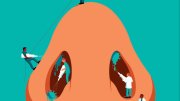Limiting potato intake—especially in the form of French fries—is associated with a lower risk of type 2 diabetes (T2D), according to a new Harvard study that offers the most comprehensive findings to date on potatoes and T2D.
The study, led by professor of epidemiology and nutrition Walter Willett and postdoctoral research fellow Seyed Mohammad Mousavi, found that three servings of French fries weekly were associated with a 20 percent higher risk of developing T2D. Although they found no association between consuming baked, boiled, or mashed potatoes and increased risk of T2D, replacing potatoes altogether with whole grain sources of carbohydrates—including whole grain pasta, bread, or farro—lowered the risk of developing T2D by 4 percent. Substituting whole grains for French fries lowered the risk of developing T2D by 19 percent; even replacing refined grains like white bread, pita, or rice with whole grains, the study found, lowers T2D risk.
“We’re shifting the conversation from ‘Are potatoes good or bad?’ to a more nuanced—and useful—question,” said Mousavi. “How are they prepared, and what might we eat instead?” Their study is the first to examine the health effects of replacing potatoes with other foods in a diet.
Willett and his team studied the diets and diabetes outcomes of 205,107 enrollees in the Nurses’ Health Study (begun 1986 with 121,700 women), the Nurses’ Health Study II (begun 1989 with 116,430 women), and the Health Professionals Follow-up Study (begun 1986 with 51,529 men). The researchers tracked how often the enrollees consumed sources of carbohydrates—such as French fries, baked, boiled, and mashed potatoes, and whole grains—over the course of more than 30 years. The team also tracked the enrollees’ health diagnoses, such as T2D, and other lifestyle and health factors.
The researchers validated their results by employing a meta-analytic approach—analyzing data from previously published cohort studies to estimate the risk of developing T2D in association with potato intake and whole grain intake. The results of the team’s two meta-analyses were consistent with their findings in the new study. One meta-analysis examined data on potato consumption in 13 cohorts, and the other examined data on whole grain consumption in 11 cohorts. Both included more than 500,000 participants on four continents.
Willett also said that “limiting French fries—and choosing healthy, whole grain sources of carbohydrate could help lower the risk of type 2 diabetes across the population.” He believes policymakers developing national dietary guidelines should consider “the need to move beyond broad food categories and pay closer attention to how foods are prepared and what they’re replacing. Not all carbs—or even all potatoes—are created equal, and that distinction is crucial when it comes to shaping effective dietary guidelines.”
“The public health message here is simple and powerful,” said Willet. “Small changes in our daily diet can have an important impact on risk of type 2 diabetes.”









